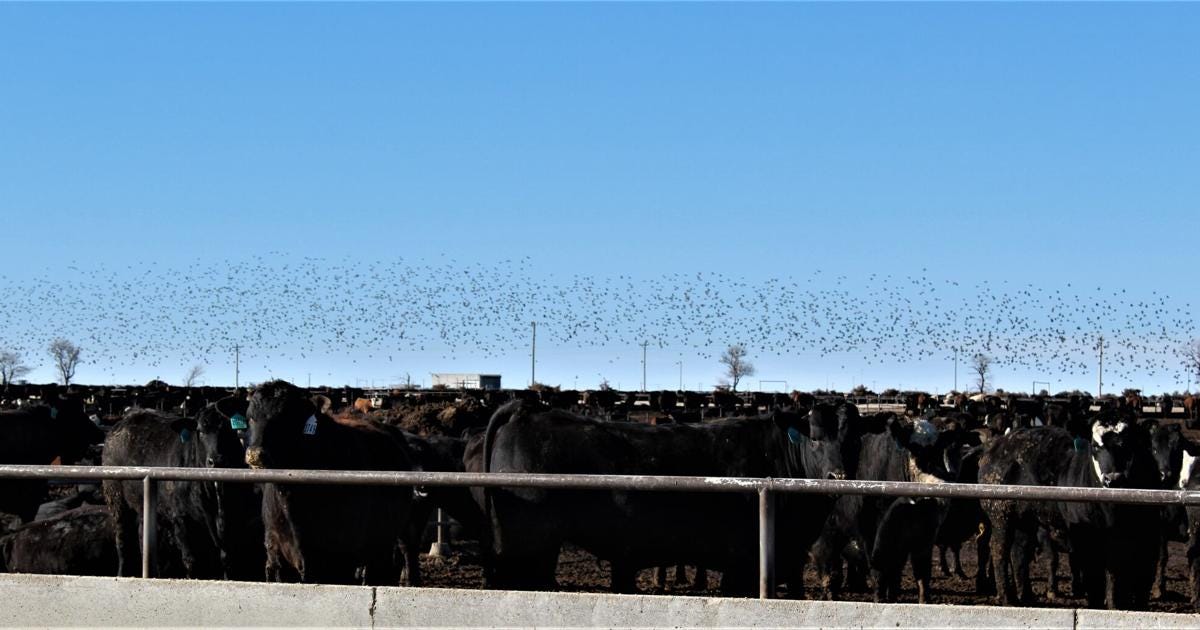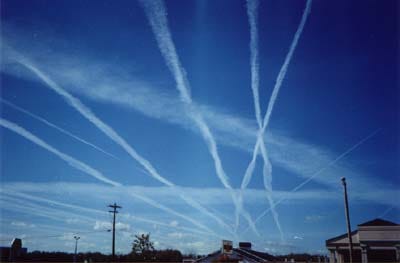H5N1 2.3.4.4b Circus Unveils Next Act: Genotype D1.1 Takes Center Stage in Cattle
Evidence of multiple avian to cattle transmission events dashes hopes for short-term eradication strategies in livestock; APHIS releases initial Nevada case analysis
On Tuesday February 5th, USDA finally confirmed what I had initially reported on the 3rd: Nevada Dairy Cattle Tentatively Infected with H5N1 2.3.4.4b D1.1:
APHIS Confirms D1.1 Genotype in Dairy Cattle in Nevada | Animal and Plant Health Inspection Service
On January 31, 2025, the USDA Animal and Plant Health Inspection Service (APHIS) National Veterinary Services Laboratories (NVSL) confirmed by whole genome sequence the first detection of highly pathogenic avian influenza (HPAI) H5N1 clade 2.3.4.4b, genotype D1.1 in dairy cattle. This confirmation was a result of State tracing and investigation, following an initial detection on silo testing under the USDA’s National Milk Testing Strategy (NMTS) in Nevada.
USDA APHIS continues to work with the Nevada Department of Agriculture by conducting additional on-farm investigation, testing, and gathering additional epidemiological information to better understand this detection and limit further disease spread.
This is the first detection of this virus genotype in dairy cattle (all previous detections in dairy cattle have been HPAI H5N1 clade 2.3.4.4b, genotype B3.13). Genotype D1.1 represents the predominant genotype in the North American flyways this past fall and winter and has been identified in wild birds, mammals, and spillovers into domestic poultry.
The detection does not change USDA’s HPAI eradication strategy and is a testament to the strength of our National Milk Testing Strategy (NTMS). In the interest of sharing information of import to the scientific community, APHIS will publish a technical brief on the findings on our website and post the sequence data on GenBank in the coming week.
I was quoted in a news release later that afternoon from the LA Times: Deadly version of H5N1 bird flu spills over into Nevada dairy cattle - Los Angeles Times
…“I can’t overemphasize what a big deal it is,” said John Korslund, a former USDA scientist, in an email. “This is truly ... unfolding into a nightmare scenario. We have no idea how widespread this version of the virus already is in cattle herds. Every time poultry flocks break (with virus), we’ll need to investigate cattle contacts (which are many) as well as wild bird and other poultry contacts.”
Quite frankly, it dumbfounds me that USDA, while praising itself for detecting virus in milk samples from multiple cow herds (now up to 6) that obviously contracted virus via multiple contacts with wild birds, continues to state that “the detection does not change USDA’s HPAI eradication strategy”. This obvious difficulty was pointed out quite well by researchers quoted in a CNN release on Wednesday: New bird flu infections in Nevada dairy cattle signal the virus may be here to stay | CNN
…. It suggests that the virus could be seeding itself into cattle through introductions from wild birds, which are ubiquitous. That could mean the H5N1 infection might become endemic, or continuously circulating, in birds in North America, and that may eventually spell trouble for people, too.
“In my opinion, it is now endemic, and it should be classified as an endemic virus,” said Dr. Louise Moncla, a pathobiologist at the University of Pennsylvania who runs a lab that studies how viruses emerge in human populations and spread.
The US Department of Agriculture classifies H5N1 as a foreign animal disease, meaning an infectious disease in animals that is not currently present in the United States. In an October news briefing, Dr. Eric Deeble, deputy undersecretary for marketing and regulatory programs at the USDA, said agriculture officials were still confident that H5N1 could be eliminated in the national herd.
Experts said repeated infections of cattle by wild birds will make that that possibility more remote.
“It’s much easier to control virus spread when you’re talking about a virus spreading from cow to cow than controlling spread from birds to cows,” said Dr. Scott Hensley, a microbiologist who studies the evolution of flu viruses at the University of Pennsylvania’s Perelman School of Medicine.
This isn’t the first time the US has had to contend with such a destructive bird flu outbreak.
In 2014, highly pathogenic H5N8 bird flu viruses from Europe arrived in North America, resulting in the destruction of more than 50 million commercially farmed birds. This aggressive culling worked. North America remained free from highly pathogenic bird flu viruses for years.
Moncla thinks this go-round with the virus will be a different story, however. She and her team recently posted a preprint study on how the H5N1 virus was introduced in North America in late 2021 and quickly found its way onto farms. By studying the evolution of the virus, they determined that spread into poultry flocks was driven by somewhere between 46 and 113 introductions of the virus from wild to farmed birds. Now, she says, with the virus spreading in so many different species of mammals and birds, it is likely to be here to stay.
Though all six of the recently infected Nevada herds are in the same valley, Dr. J.J. Goicoechea, director of the Nevada Department of Agriculture, said that after conversations with the farmers and with his state veterinarian, they believe the infection was introduced separately at each of the dairies by wild birds.
Goicoechea said there doesn’t seem to be a lot of movement of people or equipment between the dairies, which have been following strict biosecurity protocols. He said the state is working with the US Department of Agriculture on genetic testing to see whether there are changes to the virus that might help them understand its spread.
In my last post regarding the rapidly deteriorating H5N1 situation in western Ohio, I speculated about the precarious nature of “no evidence of the D1.1 genotype” in cattle or swine: H5N1 in Ohio Poultry- More Cases Coming as Ohio Swine Producers Meet to Discuss. I stated: ““We have no evidence that D1.1 is infectious in cattle and pigs”, so let’s not test…that logic will work until it doesn’t.” I didn’t realize that official testing from Nevada was already completed and pending release, which completely changes the ball game.
The Ohio cluster really raised my concerns that wild bird populations may not be the sole viral source in an area where 40+ poultry flocks were infected in a month’s time. Reliable sources indicate that beef herds in the area may have suffered significant “influenza-like” mortalities. Do we have any diagnostic results with influenza PCR results on cattle respiratory tracts? No positive milk silo reports have yet been reported from western Ohio, but what is the reporting lag? Have any swine herds with influenza like illness been tested and sequenced if matrix positive?
News came on Thursday that another highly concentrated livestock area is under H5N1 assault: Avian flu detected at commercial poultry farm in Lebanon County, ag dept. says
The Pennsylvania Department of Agriculture announced Thursday, Feb. 6, that “several commercial poultry farms in Cumberland, Dauphin, Lancaster, Lebanon, and Lehigh Counties are presumed to be HPAI positive based on the presence of the virus in initial samples, and rapid deaths among birds.”
3 Pennsylvania farms are currently on the USDA list: 1) a Lehigh County poultry flock (47,900 head); 2) a Dauphin County layer (2.1 million head); and 3) a Cumberland County broiler flock (30,000 head). The other 2 are yet to be officially listed.
Here is a map showing the 5 counties listed in the news article with the commercial flock outbreaks. I also mapped NASS dairy and swine herd inventories for Pennsylvania to illustrate that concentrated commercial livestock industries are interspersed with each other in the southeast quadrant of the state.
A complicating factor in Pennsylvania (and in parts of Ohio) are large concentrations of Amish farms. Although not high risk per se, these producers tend to market and trade livestock more frequently and as self-sufficient societies, avoid regulatory intervention as much as possible. Unregulated movements greatly complicate disease management when viruses can move between farms via traded livestock. Unfortunately, starlings and other bird populations do not differentiate between higher and lower bio-security farmsteads, raising risks for all. The jury is still out on Pennsylvania; however, concentrations of all farm species with abundant wild bird populations in this area make it a potential tinderbox.
The big tent magician’s illusion is now gone that H5N1 2.3.4.4b B3.13 was somehow a “unique single crossover dairy cow only” eradicable virus. This allowed regulators room to continue relatively unrestricted dairy and beef cattle movements and trade with the assumption that the virus was restricted to lactating dairy cows only.
The 6 Nevada cases clearly demonstrate that genotype D1.1 (and others?) can transmit repeatedly from birds to cattle. We now know that dairy cattle and likely ALL cattle are susceptible to an oronasal infection of this virus leading to upper respiratory infection (prior to udder infections and shedding in milk in lactating cows only). Separately, the Oregon swine case demonstrated that a closely related D1.2 genotype could be transmitted to swine. As long as H5N1 is present in wild birds, we have a risk that our domestic livestock may be infected, and therefore H5N1 cannot be classified as an eradicable “foreign animal disease”.
We have to come to terms with this reality if we are to develop effective surveillance strategies! Producers will not readily provide samples for genomic surveillance to a federal entity with theoretical power to destroy their livelihoods. I’m fairly confident we have endemic H5N1 2.3.4.4b D1.1 in a growing number of cattle herds and feedlots, perhaps some swine herds, and likely other species (sheep, goats, horses) as well. The risks for ongoing viral mutations and reassortments are great, and we lack incentives or creativity to gain voluntary access to these viruses for analysis.
Testing is stopped up via an antiquated foreign animal diagnostic disease process framework that producers simply will not support. We have a virus that is literally everywhere, that can only be legally collected from farm animals (and milk) by accredited personnel and sent through the federal diagnostics system. Worse, that information is closely held once collected and not fully released for public use due to “confidentiality concerns”. Our H5N1 surveillance infection coverage estimates are abysmal - we can’t even measure it because we have no idea which species are infected in which geographical areas. The National Milk Testing Strategy (NTMS), if fully implemented, will aid in assessing the dairy industry; however, its ultimate fate remains to be seen under the new administration. A bigger factor may be a lack of perceived value to the industry in addressing the problem, given the likelihood of recurring herd infections from wild bird incursions.
My vision is that we must develop new distributed ways to sample animals and their environment outside of the regulatory straitjacket to encourage capture of a broader snapshot of the “H5N1 viral sea” in which our herds and flocks swim. This infection is endemic and totally incompatible with a foreign animal disease regulatory diagnostics process. We have to let the diagnostics and analytics monopoly loose if we hope to measure this beast for its eventual assessment and control.
USDA-APHIS Technical Brief
On Friday evening USDA released its technical report on the Nevada H5N1 genotype D1.1 cases: APHIS Dairy Cattle HPAI Technical Brief
…In Nevada, 3 of 11 silo samples collected on January 6 and 7, 2025 tested positive for HPAI via polymerase chain reaction (PCR) at the National Veterinary Services Laboratories (NVSL) on January 10. The state was notified, triggering an investigation to trace the source, as up to 12 dairies (in the same geographic region) could have contributed milk to the affected silos. On January 17, regulatory officials collected on-farm bulk milk samples from suspected dairy farms and submitted them to the Washington Animal Disease Diagnostic Laboratory (WADDL), a member of the National Animal Health Laboratory Network (NAHLN). HPAI was confirmed via PCR at NVSL on Friday, January 24, in samples from two of those dairies. NVSL completed whole genome sequencing on January 31 and identified HPAI H5N1, clade 2.3.4.4b, genotype D1.1 in samples from four different bulk tanks from one herd. A second herd also showed a partial sequence consistent with D1.1. Clinical signs were not observed in the cattle prior to the detection, but have been reported since, and the affected dairy producers reported large wild bird die-offs near the dairies….
The D1.1 viruses identified in dairy cattle in Nevada were found to be closely related to other D1.1 viruses recently detected in migratory wild birds across multiple North American Flyways. Analysis of the hemagglutinin gene of the Nevada dairy cattle viruses did not identify changes predicted to impact infectivity or adaptation to mammalian hosts. However, a change of PB2 D701N commonly associated with mammalian adaptation of HPAI virus was identified in viruses sequenced from four separate dairy cattle.
…PB2 D701N has previously been associated with mammalian adaptation because it improves RNA polymerase activity and replication efficiency in mammalian cells and has the potential to impact pathogenesis in infected mammals (2,3,4,5,6). The change has previously been identified in human cases of HPAI H5 but with no evidence of onward transmission among humans (7,8). No other changes associated with mammalian adaptation were identified in the sequences.
First, I congratulate my friends at APHIS for getting this analysis out so rapidly after confirmation. I’d hope that, as the NMTS matures, time from silo or bulk tank positive to farm confirmation will greatly improve, but the system has shown it will work.
It will be interesting to see whether the PB2 D701N change is a consistent finding in subsequent D1.1 cattle spillover detections, i.e. whether this is a “convergent mutation” likely to be independently repeated. A separate question is what further mutations may occur in H5N1 2.3.4.4b D1.1 in cattle or other livestock species spillovers with further mammal to mammal onward transmission events? This is a novel finding; only ongoing isolations and sequencing will inform the scientific community of where this virus is headed in cattle and other production species.
Additionally, inoculation and transmission studies in all farm species are urgently needed as soon as possible with interim results provided as they become available. Fortuitously, this work will not be limited to the U.S. since D1.1 has also been isolated in Canada and beyond, providing multiple isolates to allow a truly international effort to perform this crucial work. A world-wide team effort is required, given the current state of uncertainty in the U.S. federal agricultural and medical research infrastructure. Additional evidence of direct avian to cattle infections may also incentivize greater speed and transparency in U.S. H5N1 research in trade-sensitive livestock species.
The other critical issue to address is the zoonotic potential of production livestock-adapted H5N1 2.3.4.4b D1.1 infections. We have no reports to date of more severe human illnesses tied to this strain in Nevada, although the Director of the Nevada Department of Agriculture in one article described minor conjunctivitis lesions in workers at the recently infected D1.1-infected dairies. Once again, we’ll see what upcoming cases may show as independent spillover events lead to new cases.
We have not seen large clusters of reported H5N1 in humans for several weeks. I believe the reason for the dearth of cases is pretty simple. Most cluster have been diagnosed in dairy farm and poultry depopulation workers, both predominantly staffed by foreign nationals of uncertain immigration status. With the advent of the Trump Administration’s announced deportation initiative, any programs that place workers in visible locations for testing also risk interfacing with immigration officials. It’s unlikely that symptomatic worker testing programs can remain attract participants in this environment.
The unfortunate reality may be that H5N1 zoonotic case finding will devolve into viral isolations from severely ill hospitalized patients as mild cases are symptomatically treated but not tested. Creative human surveillance may require non-identifiable environmental sampling to monitor genotype changes in the absence of more direct sampling campaigns. The short-term public health approach is very likely to be much more reactive than proactive.
So, the big show continues in the center ring. I would fully expect more poultry outbreaks in multiple states this week. I’d also be surprised if we don’t have another state or 2 announce D1.1 dairy herd milk detections. Once a big event premieres, usually multiple acts follow in the contrail. Reserve your front row seats now!
John









Brilliant to prep! Once this H5N1 is human to human spread the human mortality rate becomes 52-60%…. When one of every two people infected starts dying…no one will be going to work…no deliveries no healthcare workers no transportation workers no public works employees…no first responders! No one will want to take a 50% chance of dying! So wise to prep now… because once that happens there’s no prep
Thank you for this information.
You are also informing both vets and owners of domestic pets.